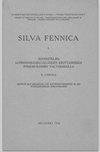评价双积分球在测量针叶反射率、透射率和反照率中的性能
IF 1.7
3区 农林科学
Q2 FORESTRY
引用次数: 7
摘要
叶片反射率和透射率光谱在许多应用中是必不可少的信息,例如开发遥感方法、计算森林冠层的短波能量平衡(反照率)以及监测树木的健康或胁迫。针叶光谱的测量通常采用单积分球进行,这涉及大量繁琐的手工工作。一个小的双积分球将使测量相当快,因为它易于操作和所需的小样本量。在这里,我们应用了一个紧凑的双积分球设置,以前用于测量阔叶,用于测量针叶。双积分球的测试测量结果显示,与完善的单积分球设置相比,针反照率的相对低估为5本文章由计算机程序翻译,如有差异,请以英文原文为准。
Evaluating the performance of a double integrating sphere in measurement of reflectance, transmittance, and albedo of coniferous needles
Leaf reflectance and transmittance spectra are essential information in many applications such as developing remote sensing methods, computing shortwave energy balance (albedo) of forest canopies, and monitoring health or stress of trees. Measurement of coniferous needle spectra has usually been carried out with single integrating spheres, which has involved a lot of tedious manual work. A small double integrating sphere would make the measurements considerably faster, because of its ease of operation and small sample sizes required. Here we applied a compact double integrating sphere setup, used previously for measurement of broad leaves, for measurement of coniferous needles. Test measurements with the double integrating sphere showed relative underestimation of needle albedo by 5â39% compared to a well-established single integrating sphere setup. A small part of the bias can be explained by the bias of the single sphere. Yet the observed bias is quite significant if absolute accuracy of measurements is required. For relative measurements, e.g. for monitoring development of needle spectra over time, the double sphere system provides notable improvement. Furthermore, it might be possible to reduce the bias by building an optimized measurement setup that minimizes absorption losses in the sample port. Our study indicates that double spheres, after some technical improvement, may provide a new and fast way to collect extensive spectral libraries of tree species.
求助全文
通过发布文献求助,成功后即可免费获取论文全文。
去求助
来源期刊

Silva Fennica
农林科学-林学
CiteScore
3.50
自引率
11.10%
发文量
21
审稿时长
3 months
期刊介绍:
Silva Fennica publishes significant new knowledge on forest sciences. The scope covers research on forestry and forest ecosystems. Silva Fennica aims to increase understanding on forest ecosystems, and sustainable use and conservation of forest resources. Use of forest resources includes all aspects of forestry containing biomass-based and non-timber products, economic and social factors etc.
 求助内容:
求助内容: 应助结果提醒方式:
应助结果提醒方式:


